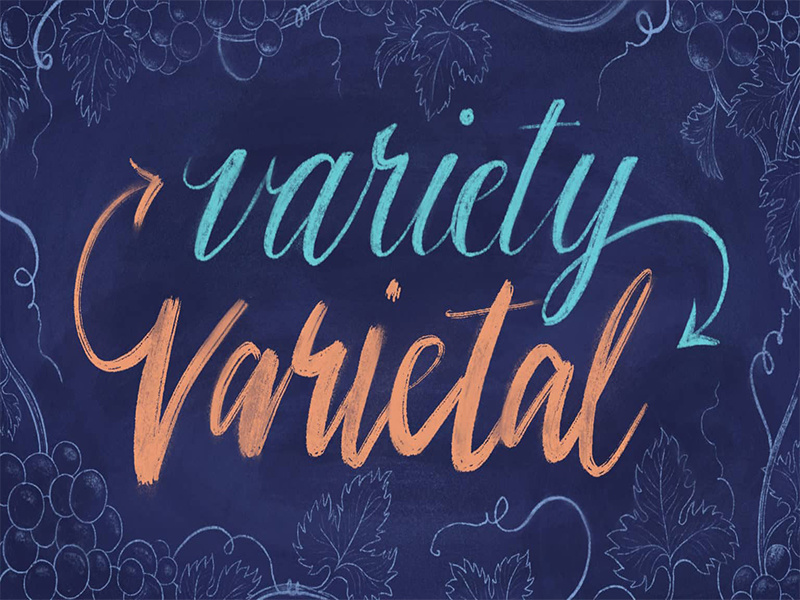Variety of Varietal Wines
- Posted on
- Posted in Cabernet Franc, chardonnay, france, pinot noir, Sauvignon Blanc
- 0

Did you see what we did there? The terms “variety” and “varietal wine” are often used interchangeably, and City Vino would like to help make somewhat of a distinction between the two terms.
“Variety” is often used as a term that equates to the grape itself. In the way that Granny Smith is a variety of apple, Pinot Noir is a variety of grape. It gets more specific when you get to the scientific terms like genus, species, and subspecies but let us stick with our original discussion.
The term “varietal,” which is an adjective, is usually used to denote a wine that is made from a single or a dominant grape variety. A bottle of wine made from 100 percent Pinot Noir would be deemed to be “a varietal Pinot Noir.”
That being said, for the variety name to be listed on the front label of the wine bottle there are different rules that apply depending on where the wine is made in the world and tends to be a bit complicated. In most of the US, with a few exceptions, for a wine to be labelled Chardonnay it would have to be at least 75 percent Chardonnay. If the US-made wine were to be exported into the European Union, and was labelled Chardonnay, it would have to be at least 85 percent Chardonnay. A 75 percent Chardonnay could not be exported there without a change to the label.
Often in the Old World, in countries like France and Italy, wine labels often do not like the variety name on the label, as the wines are labeled with the region name where they are made. A red wine made in Saumur-Champigny, and labeled as such from the Saumur appellation in the Loire Valley, is usually 100 percent Cabernet Franc, but by law is allowed to be up to 15 percent Cabernet Sauvignon and/or Pinea d ’Aunis. On the white wine side, a wine labeled as Mâcon-Davayé, which is in the Mâconnais region in France, would always be100 percent Chardonnay.
In keeping with our discussion of a variety of varietal wines, this weekend’s tasting features four French wines, all made as varietal wines and all from 100 percent of the respective grape variety. Got that?
For our white wine, we have the 2019 Domaine de la Croix Senaillet Mâcon-Davayé France, which is 100 percent Chardonnay. This lovely pale-yellow-colored wine bursts with aromas of green apples, fresh lemon peel, pear, white peaches, honeysuckles, and a hint of sea air. A taste of the wine shows that those characteristics are echoed along with cream, pineapple, and pie crust. This expression of the grape has a medium body, medium plus acidity, and a nice finish. Pair with fish or something with a light cream sauce.
The rosé wine in our tasting last week is the 2020 Château La Mothe Du Barry Clairet Cuvée French Kiss Rosé, from Bordeaux, France. It may surprise you that this wine is 100 percent Merlot. Ripe strawberries try to jump out of the glass at you. On the palate this bright, fruity, yet dry wine has a medium body. We would suggest that you pair it with a nice bowl of chili or some roasted meat like lamb or duck. This week, however, we will be featuring Chateau La Mothe du Barry Cuvée French Kiss Entre Deux Mers France 2020, which is from the same winery. It is considered a white blend considering its makeup does not have a dominate varietal. The blend and tasting note are as follows, 40 percent Sauvignon Blanc, 40 percent Sauvignon Gris, and 20 percent Semillon. It is very aromatic, floral with nuances of white peach, flint, honey, apple, lime, and minerals. This would be great with shellfish as an appetizer, or with vegetarian dishes.
As for reds, we have two for you. The first of the reds is the 2018 Bavencoff Pinot Noir Bourgogne, from Burgundy, France. Red wines from Burgundy (Bourgogne) are made from Pinot Noir and this is indeed 100 percent of that grape. Beautiful in your glass, with medium-purplish hues. The intense nose features cherries, kirsch (cherry liquor), and freshly picked berries. This medium-bodied gem has silky and elegant textures, and a long finish. Serve with grilled meats, roasts, game, and soft cheeses.
Our final wine, and the second of our red wines, is the 2018 Château du Hureau Tuffe, from Saumur-Champigny, France. If you had remembered the information from above, yes, you could surmise that this wine is indeed 100 percent Cabernet Franc. Notes of wild raspberries, cherry compote, and freshly picked strawberries arise from the glass with a simple swirl. The palate is complex, with layers of blackberry, black pepper, black plum, earth, and tobacco. With its earthiness, a dish with mushrooms would be a great pairing, whether sauteed alongside meat or featured in a risotto.
This wine is highly fragrant, with wild raspberries, cherry compote, and young strawberry on the nose. It offers more complexity on the palate, with layers of blackberry, black pepper, dark plum, hints of earthy herbaceous notes, and tobacco. Other pairings would include roasted poultry, grilled meats, and rich cheeses.
We hope you have a great week and join us this weekend to try a variety of varietal wines!

Comments
Be the first to comment...